Abstract
This paper is a review of published reports, in English, of educational programs designed to change smoking behavior. Attempts to change the smoking behavior of young people have included anti-smoking campaigns, youth-to-youth programs, and a variety of message themes and teaching methods. Instruction has been presented both by teachers who were committed or persuasive and by teachers who were neutral or presented both sides of the issue. Didactic teaching, group discussion, individual study, peer instruction, and mass media have been employed. Health effects of smoking, both short- and long-term effects, have been emphasized. Most methods used with youth have shown little success. Studies of other methods have produced contradictory results. Educational programs for adults have included large scale anti-smoking campaigns, smoking cessation clinics, and a variety of more specific withdrawal methods. These methods have included individual counseling, emotional role playing, aversive conditioning, desensitization, and specific techniques to reduce the likelihood that smoking will occur in situations previously associated with smoking. Some of these techniques have produced poor results while studies of other methods have shown inconsistent results. The two methods showing the most promise are individual counseling and smoking withdrawal clinics.
Full text
PDF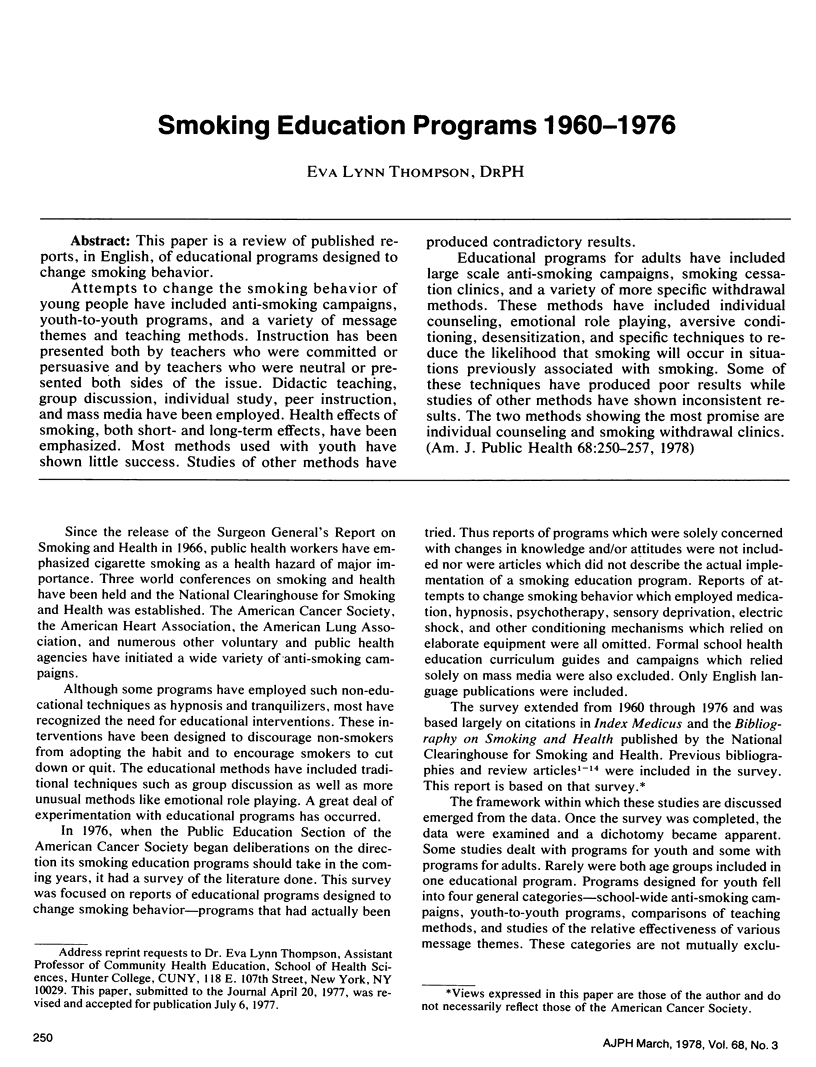
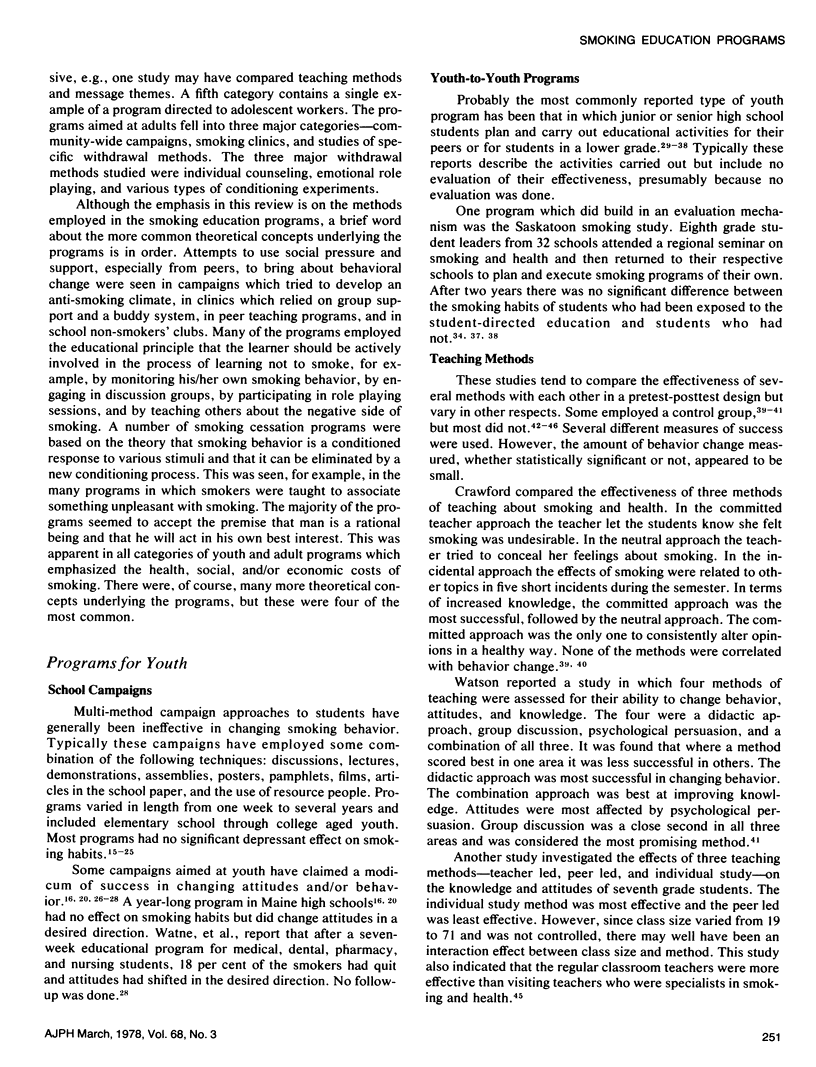
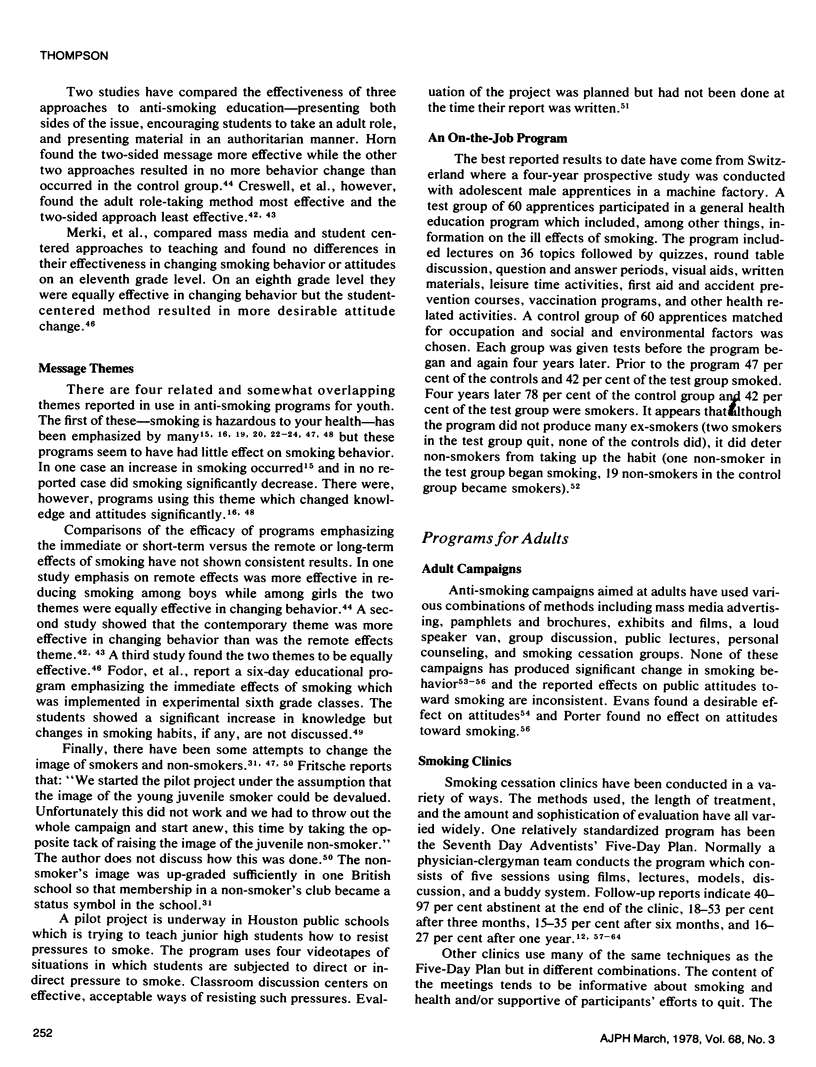
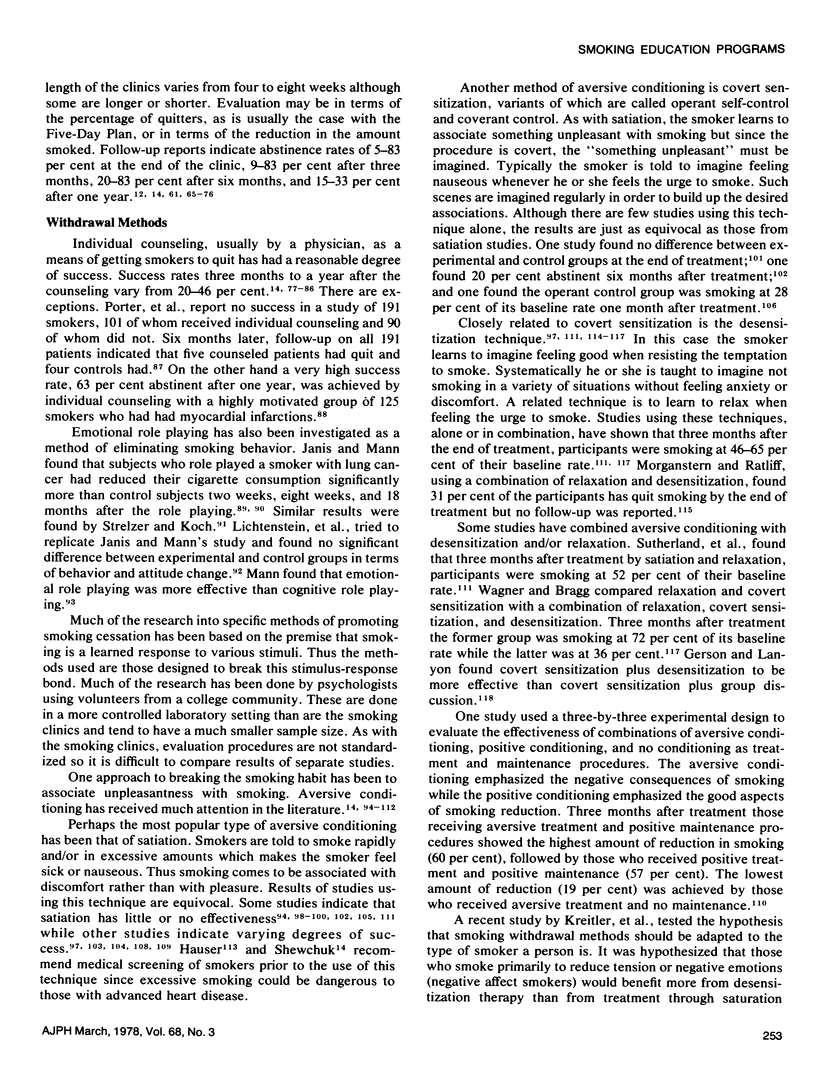
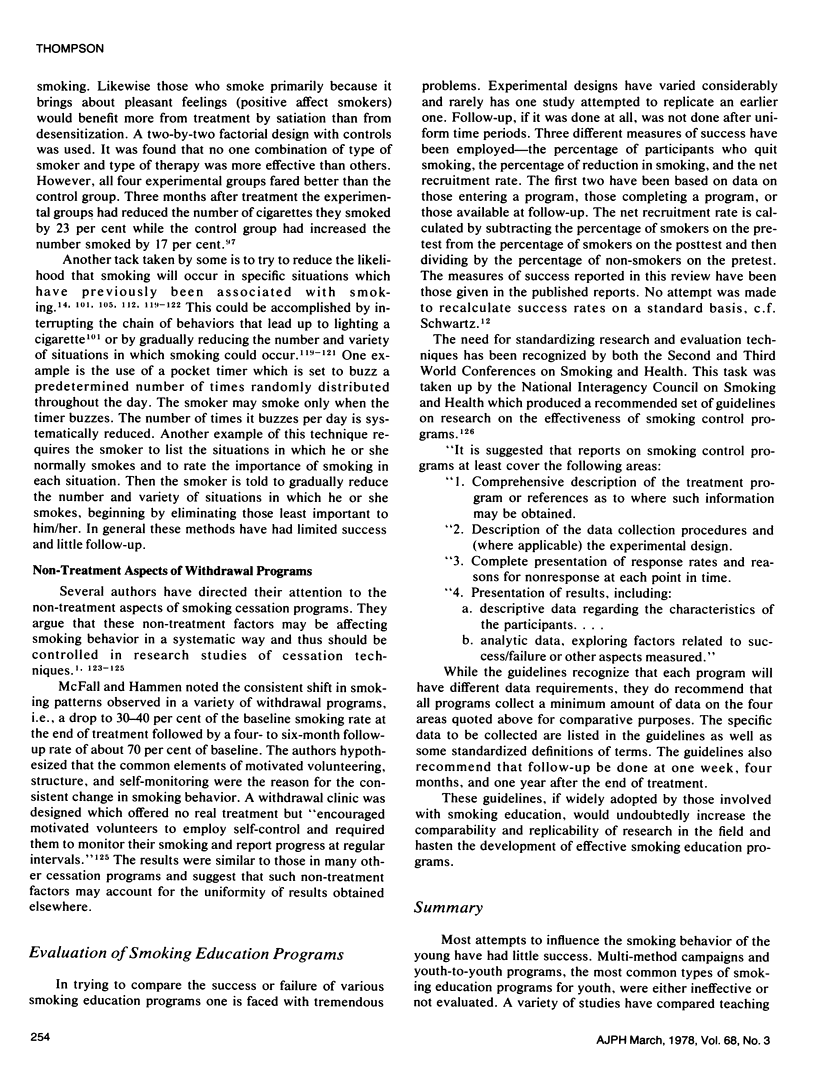

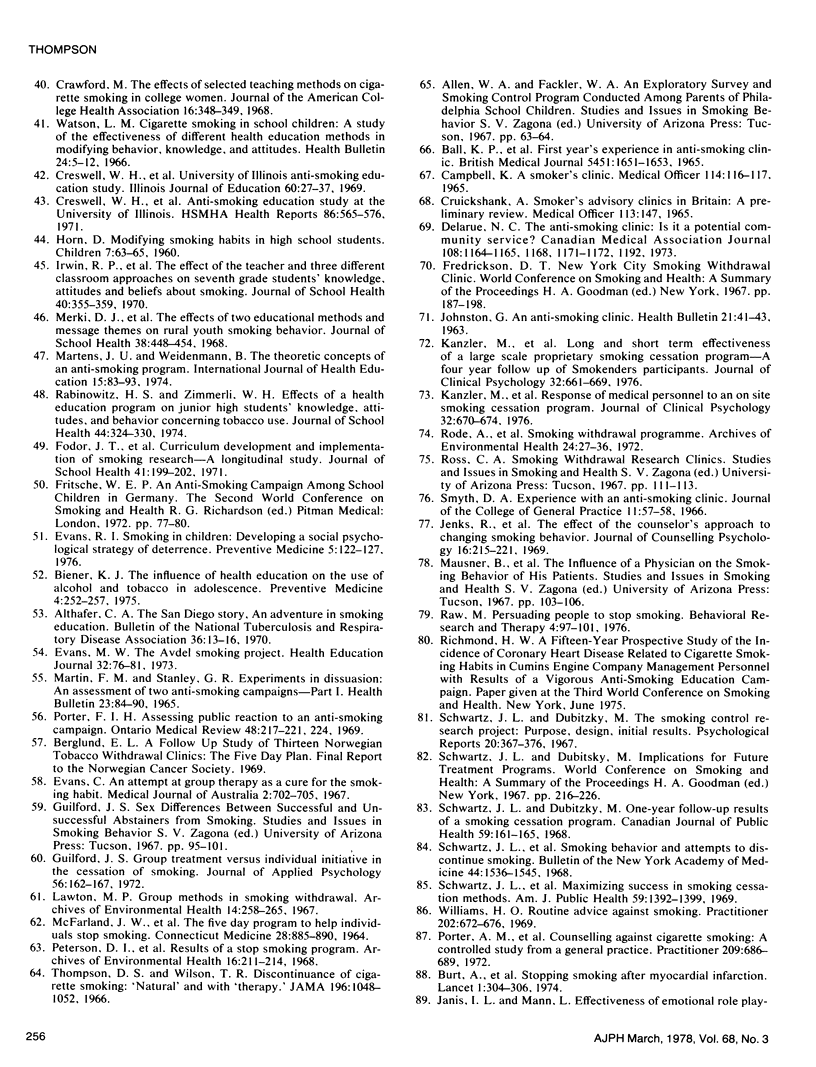
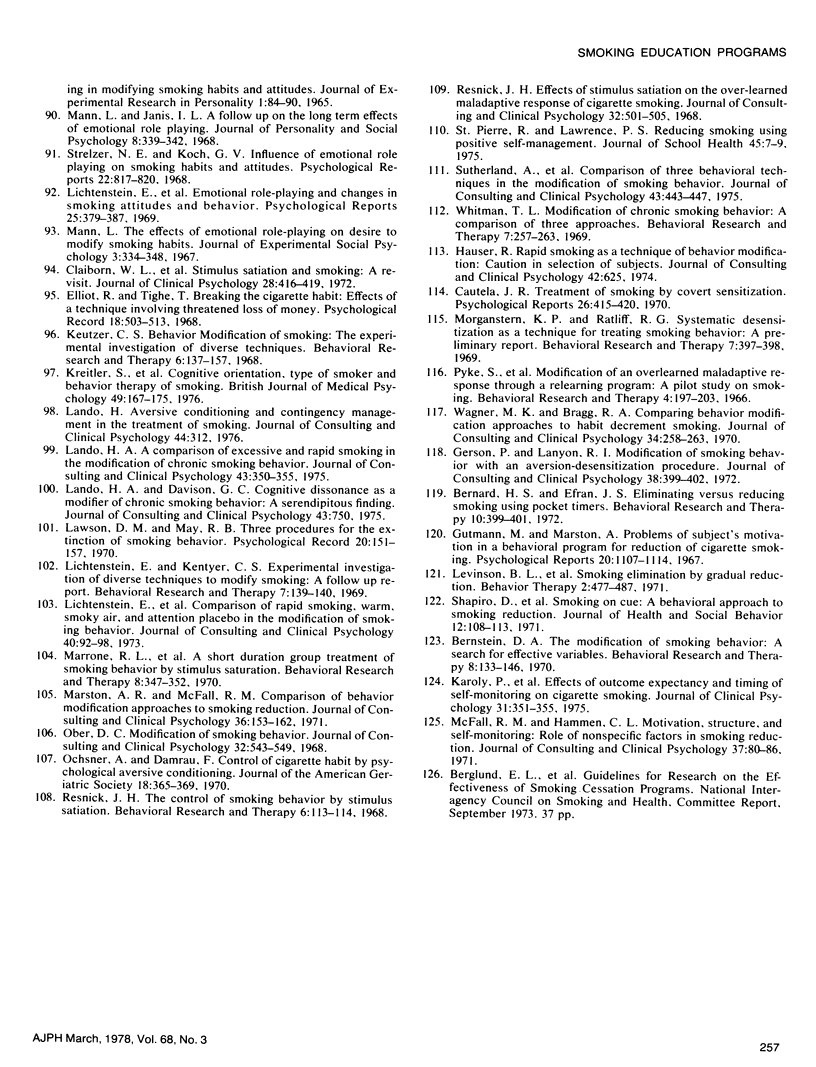
Selected References
These references are in PubMed. This may not be the complete list of references from this article.
- ANDRUS L. H., HYDE D. F., FISCHER E. SMOKING BY HIGH SCHOOL STUDENTS. FAILURE OF A CAMPAIGN TO PERSUADE ADOLESCENTS NOT TO SMOKE. Calif Med. 1964 Oct;101:246–247. [PMC free article] [PubMed] [Google Scholar]
- BALL K. P., KIRBY B. J., BOGEN C. FIRST YEAR'S EXPERIENCE IN ANTI-SMOKING CLINIC. Br Med J. 1965 Jun 26;1(5451):1651–1653. doi: 10.1136/bmj.1.5451.1651. [DOI] [PMC free article] [PubMed] [Google Scholar]
- BECKERMAN S. C. Report of an educational program regarding cigarette smoking among high school students. J Maine Med Assoc. 1963 Mar;54:60–63. [PubMed] [Google Scholar]
- Bernard H. S., Efran J. S. Eliminating versus reducing smoking using pocket timers. Behav Res Ther. 1972 Nov;10(4):399–401. doi: 10.1016/0005-7967(72)90063-0. [DOI] [PubMed] [Google Scholar]
- Bernstein D. A. Modification of smoking behavior: an evaluative review. Psychol Bull. 1969 Jun;71(6):418–440. doi: 10.1037/h0027367. [DOI] [PubMed] [Google Scholar]
- Bernstein D. A. The modification of smoking behavior: a search for effective variables. Behav Res Ther. 1970 May;8(2):133–146. doi: 10.1016/0005-7967(70)90083-5. [DOI] [PubMed] [Google Scholar]
- Biener K. J. The influence of health education on the use of alcohol and tobacco in adolescence. Prev Med. 1975 Sep;4(3):252–257. doi: 10.1016/0091-7435(75)90061-4. [DOI] [PubMed] [Google Scholar]
- Bradshaw P. W. The problem of cigarette smoking and its control. Int J Addict. 1973;8(2):353–371. doi: 10.3109/10826087309057481. [DOI] [PubMed] [Google Scholar]
- Burt A., Thornley P., Illingworth D., White P., Shaw T. R., Turner R. Stopping smoking after myocardial infarction. Lancet. 1974 Feb 23;1(7852):304–306. doi: 10.1016/s0140-6736(74)92607-5. [DOI] [PubMed] [Google Scholar]
- CRAMER T. ANTI-SCHOOLCHILD-SMOKING CAMPAGIN IN DENMARK. Acta Unio Int Contra Cancrum. 1963;19:935–936. [PubMed] [Google Scholar]
- Campbell L. P. Modifying attitudes of upper elementary students toward smoking. J Sch Health. 1974 Feb;44(2):97–98. [PubMed] [Google Scholar]
- Cautela J. R. Treatment of smoking by covert sensitization. Psychol Rep. 1970 Apr;26(2):415–420. doi: 10.2466/pr0.1970.26.2.415. [DOI] [PubMed] [Google Scholar]
- Claiborn W. L., Lewis P., Humble S. Stimulus satiation and smoking: a revisit. J Clin Psychol. 1972 Jul;28(3):416–419. [PubMed] [Google Scholar]
- Crawford M. The effects of selected teaching methods on cigarette smoking in college women. J Am Coll Health Assoc. 1968 Apr;16(4):348–349. [PubMed] [Google Scholar]
- Creswell W. H., Jr, Stone D. B., Huffman W. J., Newman I. M. Antismoking education study at the University of Illinois. HSMHA Health Rep. 1971 Jun;86(6):565–576. [PMC free article] [PubMed] [Google Scholar]
- Estrin E. R., Querry D. L. A "No-Smoking" project for ninth and tenth grades. J Sch Health. 1965 Oct;35(8):381–382. [PubMed] [Google Scholar]
- Evans C. An attempt at group therapy as a cure for the smoking habit. Med J Aust. 1967 Oct 7;2(15):702–705. doi: 10.5694/j.1326-5377.1967.tb74174.x. [DOI] [PubMed] [Google Scholar]
- Evans R. I. Smoking in children: developing a social psychological strategy of deterrence. Prev Med. 1976 Mar;5(1):122–127. doi: 10.1016/0091-7435(76)90015-3. [DOI] [PubMed] [Google Scholar]
- Evans R. R., Borgatta E. F. An experiment in smoking dissuasion among university freshmen: a follow-up. J Health Soc Behav. 1970 Mar;11(1):30–36. [PubMed] [Google Scholar]
- Fodor J. T., Glass L. H. Curriculum development and implementation of smoking research--a longitudinal study. J Sch Health. 1971 Apr;41(4):199–202. doi: 10.1111/j.1746-1561.1971.tb03701.x. [DOI] [PubMed] [Google Scholar]
- Ford S., Jr, Ederer F. Breaking the cigarette habit. JAMA. 1965 Oct 11;194(2):139–142. [PubMed] [Google Scholar]
- Gerson P., Lanyon R. I. Modification of smoking behavior with an aversion-desensitization procedure. J Consult Clin Psychol. 1972 Jun;38(3):399–402. doi: 10.1037/h0032907. [DOI] [PubMed] [Google Scholar]
- Guilford J. S. Group treatment versus individual initiative in the cessation of smoking. J Appl Psychol. 1972 Apr;56(2):162–167. doi: 10.1037/h0032616. [DOI] [PubMed] [Google Scholar]
- HORNE T. SMOKING AND HEALTH. THE ACTIVITIES OF A HIGH SCHOOL STUDENT COMMITTEE. J Sch Health. 1963 Dec;33:451–456. [PubMed] [Google Scholar]
- Hauser R. Rapid smoking as a technique of behavior modification: caution in selection of subjects. J Consult Clin Psychol. 1974 Aug;42(4):625–626. doi: 10.1037/h0020029. [DOI] [PubMed] [Google Scholar]
- Holland W. W., Elliott A. Cigarette smoking, respiratory symptoms, and anti-smoking propaganda. An experiment. Lancet. 1968 Jan 6;1(7532):41–43. doi: 10.1016/s0140-6736(68)90026-3. [DOI] [PubMed] [Google Scholar]
- Hunt W. A., Bespalec D. A. An evaluation of current methods of modifying smoking behavior. J Clin Psychol. 1974 Oct;30(4):431–438. doi: 10.1002/1097-4679(197410)30:4<431::aid-jclp2270300402>3.0.co;2-5. [DOI] [PubMed] [Google Scholar]
- Hunt W. A., Matarazzo J. D. Three years later: recent developments in the experimental modification of smoking behavior. J Abnorm Psychol. 1973 Apr;81(2):107–114. doi: 10.1037/h0034553. [DOI] [PubMed] [Google Scholar]
- Irwin R. P., Creswell W. H., Jr, Stauffer D. J. The effect of the teacher and three different classroom approaches on seventh grade students' knowledge, attitudes and beliefs about smoking. J Sch Health. 1970 Sep;40(7):355–359. doi: 10.1111/j.1746-1561.1970.tb05622.x. [DOI] [PubMed] [Google Scholar]
- Jones J. A., Piper G. W., Matthews V. L. A student-directed program in smoking education. Can J Public Health. 1970 May-Jun;61(3):253–256. [PubMed] [Google Scholar]
- Kanzler M., Jaffe J. H., Zeidenberg P. Long- and short-term effectiveness of a large-scale proprietary smoking cessation program. -A 4-year follow-up of Smokenders participants. J Clin Psychol. 1976 Jul;32(3):661–669. [PubMed] [Google Scholar]
- Kanzler M., Zeidenberg P., Jaffe J. H. Response of medical personnel to an on-site smoking cessation program. J Clin Psychol. 1976 Jul;32(3):670–674. [PubMed] [Google Scholar]
- Karoly P., Doyle W. W. Effects of outcome expectancy and timing of self-monitoring on cigarette smoking. J Clin Psychol. 1975 Apr;31(2):351–355. doi: 10.1002/1097-4679(197504)31:2<351::aid-jclp2270310243>3.0.co;2-3. [DOI] [PubMed] [Google Scholar]
- Keutzer C. S. Behavior modification of smoking: the experimental investigation of diverse techniques. Behav Res Ther. 1968 May;6(2):137–157. doi: 10.1016/0005-7967(68)90001-6. [DOI] [PubMed] [Google Scholar]
- Kreitler S., Shahar A., Kreitler H. Cognitive orientation, type of smoker and behavior therapy of smoking. Br J Med Psychol. 1976 Jun;49(2):167–175. doi: 10.1111/j.2044-8341.1976.tb02361.x. [DOI] [PubMed] [Google Scholar]
- Kroll H. W. Bibliography on behavioral approaches to modification of smoking: January 1964 through December 1973. Psychol Rep. 1974 Aug;35(1 Pt 2):435–440. doi: 10.2466/pr0.1974.35.1.435. [DOI] [PubMed] [Google Scholar]
- Lando H. A. A comparison of excessive and rapid smoking in the modification of chronic smoking behavior. J Consult Clin Psychol. 1975 Jun;43(3):350–355. doi: 10.1037/h0076741. [DOI] [PubMed] [Google Scholar]
- Lando H. A. Aversive conditioning and contingency management in the treatment of smoking. J Consult Clin Psychol. 1976 Apr;44(2):312–312. doi: 10.1037//0022-006x.44.2.312. [DOI] [PubMed] [Google Scholar]
- Lando H. A., Davison G. C. Cognitive dissonance as a modifier of chronic smoking behavior: a serendipitous finding. J Consult Clin Psychol. 1975 Oct;43(5):750–750. doi: 10.1037//0022-006x.43.5.750. [DOI] [PubMed] [Google Scholar]
- Laughlin T. J., Wake F. R. Socio-psychological aspects of cigarette smoking. Can J Public Health. 1970 Jul-Aug;61(4):301–312. [PubMed] [Google Scholar]
- Lawton M. P. Group methods in smoking withdrawal. Arch Environ Health. 1967 Feb;14(2):258–265. doi: 10.1080/00039896.1967.10664728. [DOI] [PubMed] [Google Scholar]
- Lichtenstein E., Harris D. E., Birchler G. R., Wahl J. M., Schmahl D. P. Comparison of rapid smoking, warm, smoky air, and attention placebo in the modification of smoking behavior. J Consult Clin Psychol. 1973 Feb;40(1):92–98. doi: 10.1037/h0034039. [DOI] [PubMed] [Google Scholar]
- Lichtenstein E., Keutzer C. S. Experimental investigation of diverse techniques to modify smoking: a follow-up report. Behav Res Ther. 1969 Feb;7(1):139–140. doi: 10.1016/0005-7967(69)90060-6. [DOI] [PubMed] [Google Scholar]
- Lichtenstein E., Keutzer C. S., Himes K. H. "Emotional" role-playing and changes in smoking attitudes and behavior. Psychol Rep. 1969 Oct;25(2):379–387. doi: 10.2466/pr0.1969.25.2.379. [DOI] [PubMed] [Google Scholar]
- MCFARLAND J. W., GIMBEL H. W., DONALD W. A., FOLKENBERG E. J. THE FIVE-DAY PROGRAM TO HELP INDIVIDUALS STOP SMOKING. A PRELIMINARY REPORT. Conn Med. 1964 Dec;28:885–890. [PubMed] [Google Scholar]
- MONK M., TAYBACK M., GORDON J. EVALUATION OF AN ANTISMOKING PROGRAM AMONG HIGH SCHOOL STUDENTS. Am J Public Health Nations Health. 1965 Jul;55:994–1004. doi: 10.2105/ajph.55.7.994. [DOI] [PMC free article] [PubMed] [Google Scholar]
- MORISON J. B. CIGARETTE SMOKING: SURVEYS AND A HEALTH EDUCATION PROGRAM IN WINNIPEG, MANITOBA. Can J Public Health. 1964 Jan;55:16–22. [PubMed] [Google Scholar]
- MORISON J. B., MEDOVY H., MACDONELL G. T. HEALTH EDUCATION AND CIGARETTE SMOKING: A REPORT ON A THREE-YEAR PROGRAM IN THE WINNIPEG SCHOOL DIVISION, 1960-1963. Can Med Assoc J. 1964 Jul 11;91:49–56. [PMC free article] [PubMed] [Google Scholar]
- Mann L., Janis I. L. A follow-up study on the long-term effects of emotional role playing. J Pers Soc Psychol. 1968 Apr;8(4):339–342. doi: 10.1037/h0021243. [DOI] [PubMed] [Google Scholar]
- Marrone R. L., Merksamer M. A., Salzberg P. M. A short duration group treatment of smoking behavior by stimulus saturation. Behav Res Ther. 1970 Nov;8(4):347–352. doi: 10.1016/0005-7967(70)90054-9. [DOI] [PubMed] [Google Scholar]
- Marston A. R., McFall R. M. Comparison of behavior modification approaches to smoking reduction. J Consult Clin Psychol. 1971 Apr;36(2):153–162. doi: 10.1037/h0030736. [DOI] [PubMed] [Google Scholar]
- McFall R. M., Hammen C. L. Motivation, structure, and self-monitoring: role of nonspecific factors in smoking reduction. J Consult Clin Psychol. 1971 Aug;37(1):80–86. doi: 10.1037/h0031279. [DOI] [PubMed] [Google Scholar]
- McRae C. F., Nelson D. M. Youth to youth communication on smoking and health. J Sch Health. 1971 Oct;41(8):445–447. doi: 10.1111/j.1746-1561.1971.tb05142.x. [DOI] [PubMed] [Google Scholar]
- Mees H. L., Keutzer C. S., Lichtenstein E. Modification of smoking behavior: a review. Psychol Bull. 1968 Dec;70(6):520–533. doi: 10.1037/h0026834. [DOI] [PubMed] [Google Scholar]
- Merki D. J., Creswell W. H., Stone D. B., Huffman W., Newman I. The effects of two educational methods and message themes on rural youth smoking behavior. J Sch Health. 1968 Sep;38(7):448–454. doi: 10.1111/j.1746-1561.1968.tb07033.x. [DOI] [PubMed] [Google Scholar]
- Morganstern K. P., Ratliff R. G. Systematic desensitization as a technique for treating smoking behavior: a preliminary report. Behav Res Ther. 1969 Nov;7(4):397–398. doi: 10.1016/0005-7967(69)90070-9. [DOI] [PubMed] [Google Scholar]
- Neeman R. L., Neeman M. Complexities of smoking education. J Sch Health. 1975 Jan;45(1):17–23. doi: 10.1111/j.1746-1561.1975.tb04459.x. [DOI] [PubMed] [Google Scholar]
- Ober D. C. Modification of smoking behavior. J Consult Clin Psychol. 1968 Oct;32(5):543–549. doi: 10.1037/h0026403. [DOI] [PubMed] [Google Scholar]
- Ochsner A., Damrau F. Control of cigarette habit by psychological aversive conditioning: clinical evaluation in 53 smokers. J Am Geriatr Soc. 1970 May;18(5):365–369. doi: 10.1111/j.1532-5415.1970.tb03667.x. [DOI] [PubMed] [Google Scholar]
- Peterson D. I., Lonergan L. H., Hardinge M. G., Teel C. W. Results of a stop-smoking program. Arch Environ Health. 1968 Feb;16(2):211–214. doi: 10.1080/00039896.1968.10665045. [DOI] [PubMed] [Google Scholar]
- Piper G. W., Jones J. A., Matthews V. L. The Saskatoon Smoking Study. Results of the first year. Can J Public Health. 1971 Sep-Oct;62(5):432–441. [PubMed] [Google Scholar]
- Piper G. W., Jones J. A., Matthews V. L. The Saskatoon smoking study: results of the second year. Can J Public Health. 1974 Mar-Apr;65(2):127–129. [PubMed] [Google Scholar]
- Porter A. M., McCullough D. M. Counselling against cigarette smoking. A controlled study from a general practice. Practitioner. 1972 Nov;209(253):686–689. [PubMed] [Google Scholar]
- Rabinowitz H. S., Zimmerli W. H. Effects of a health education program on junior high school students' knowledge, attitudes, and behavior concerning tobacco use. J Sch Health. 1974 Jun;44(6):324–330. doi: 10.1111/j.1746-1561.1974.tb07646.x. [DOI] [PubMed] [Google Scholar]
- Resnick J. H. Effects of stimulus satiation on the overlearned maladaptive response of cigarette smoking. J Consult Clin Psychol. 1968 Oct;32(5):501–505. doi: 10.1037/h0026392. [DOI] [PubMed] [Google Scholar]
- Resnick J. H. The control of smoking behavior by stimulus satiation. Behav Res Ther. 1968 Feb;6(1):113–114. doi: 10.1016/0005-7967(68)90050-8. [DOI] [PubMed] [Google Scholar]
- Rode A., Ross R., Shephard R. J. Smoking withdrawal programme. Personality and cardiorespiratory fitness. Arch Environ Health. 1972 Jan;24(1):27–36. doi: 10.1080/00039896.1972.10666046. [DOI] [PubMed] [Google Scholar]
- Sadler M. A pilot program in health education related to the hazards of cigarette smoking. R I Med J. 1969 Jan;52(1):36–38. [PubMed] [Google Scholar]
- Schwartz J. L. A critical review and evaluation of smoking control methods. Public Health Rep. 1969 Jun;84(6):483–506. [PMC free article] [PubMed] [Google Scholar]
- Schwartz J. L., Dubitzky M. Maximizing success in smoking cessation methods. Am J Public Health Nations Health. 1969 Aug;59(8):1392–1399. doi: 10.2105/ajph.59.8.1392. [DOI] [PMC free article] [PubMed] [Google Scholar]
- Schwartz J. L., Dubitzky M. One-year follow-up results of a smoking cessation program. Can J Public Health. 1968 Apr;59(4):161–165. [PubMed] [Google Scholar]
- Schwartz J. L., Dubitzky M. Smoking behavior and attempts to discontinue smoking. Bull N Y Acad Med. 1968 Dec;44(12):1536–1545. [PMC free article] [PubMed] [Google Scholar]
- Schwartz J. L., Dubitzky M. The smoking control research project: purpose, design, and initial results. Psychol Rep. 1967 Apr;20(2):367–376. doi: 10.2466/pr0.1967.20.2.367. [DOI] [PubMed] [Google Scholar]
- Shapiro D., Schwartz G. E., Tursky B., Shnidman S. R. Smoking on cue: a behavioral approach to smoking reduction. J Health Soc Behav. 1971 Jun;12(2):108–113. [PubMed] [Google Scholar]
- Shewchuk L. A. Smoking cessation programs of the American Health Foundation. Prev Med. 1976 Sep;5(3):454–474. doi: 10.1016/0091-7435(76)90061-x. [DOI] [PubMed] [Google Scholar]
- Streltzer N. E., Koch G. V. Influence of emotional role-playing on smoking habits and attitudes. Psychol Rep. 1968 Jun;22(3):817–820. doi: 10.2466/pr0.1968.22.3.817. [DOI] [PubMed] [Google Scholar]
- Sutherland A., Amit Z., Golden M., Roseberger Z. Comparison of three behavioral techniques in the modification of smoking behavior. J Consult Clin Psychol. 1975 Aug;43(4):443–447. doi: 10.1037/h0076775. [DOI] [PubMed] [Google Scholar]
- Thompson D. S., Wilson T. R. Discontinuance of cigarette smoking: "natural" and with "therapy". A ten-week and ten-month follow-up study of 298 adult participants in a five-day plan to stop smoking. JAMA. 1966 Jun 20;196(12):1048–1052. doi: 10.1001/jama.196.12.1048. [DOI] [PubMed] [Google Scholar]
- WATNE A. L., MONTGOMERY R. L., PETTIT W. W. A CIGARETTE INFORMATION PROGRAM. JAMA. 1964 Jun 8;188:872–874. doi: 10.1001/jama.1964.03060360032007. [DOI] [PubMed] [Google Scholar]
- Wagner M. K., Bragg R. A. Comparing behavior modification approaches to habit decrement--smoking. J Consult Clin Psychol. 1970 Apr;34(2):258–263. doi: 10.1037/h0029000. [DOI] [PubMed] [Google Scholar]
- Whitman T. L. Modification of chronic smoking behavior: A comparison of three approaches. Behav Res Ther. 1969 Sep;7(3):257–263. doi: 10.1016/0005-7967(69)90005-9. [DOI] [PubMed] [Google Scholar]
- Williams H. O. Routine advice against smoking. A chest clinic pilot stdy. Practitioner. 1969 May;202(211):672–676. [PubMed] [Google Scholar]


